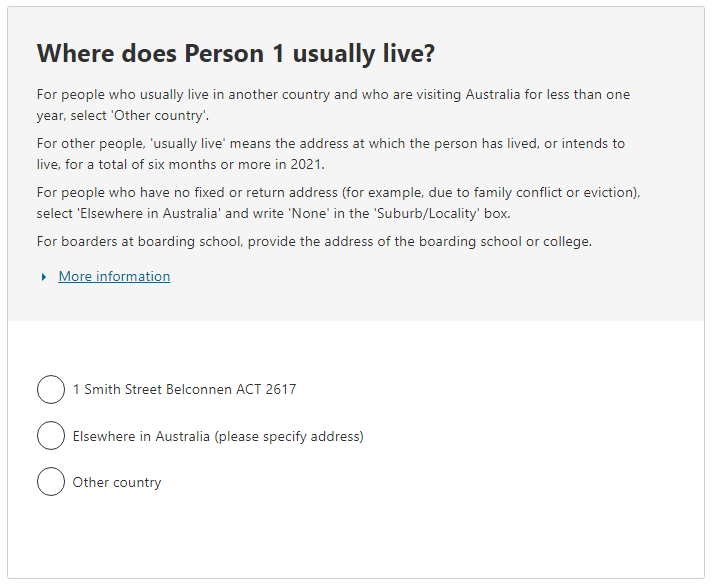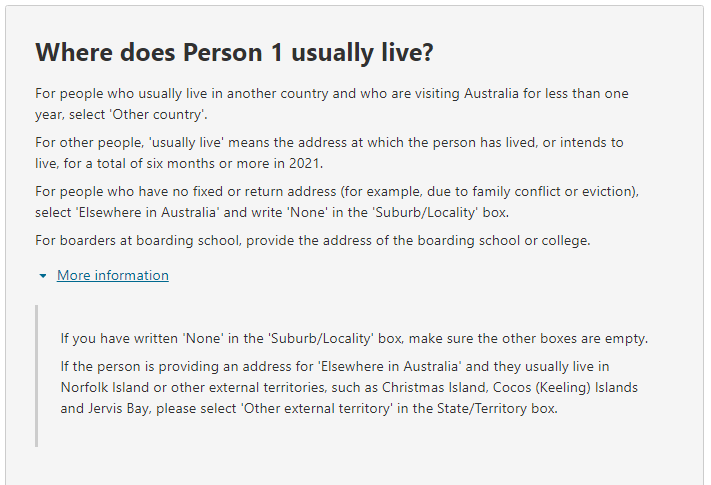Image

Description
More information
Image

This variable records the operational group of persons estimated to be homeless or marginally housed on Census Night.
All persons who are estimated to be homeless or marginally housed
| Code | Category |
|---|---|
| Homelessness operational groups | |
| 1 | Persons living in improvised dwellings, tents or sleeping out |
| 2 | Persons in supported accommodation for the homeless |
| 3 | Persons staying temporarily with other households |
| 4 | Persons living in boarding houses |
| 5 | Persons in other temporary lodgings |
| 6 | Persons living in ‘severely’ crowded dwellings |
| Other marginal housing groups | |
| 7 | Persons living in other crowded dwellings |
| 8 | Persons in other improvised dwellings |
| 9 | Persons who are marginally housed in caravan parks |
| Not applicable | |
| @ | Not Applicable |
Number of categories: 10
Not applicable comprises:
The homelessness enumeration strategy uses support from service providers and a range of Census forms to capture the data. Rough sleepers were captured using the Special short form. Couch surfers and other people in temporary lodgings were captured using the Census Household form and were instructed to respond 'none' to the usual address question. Some Aboriginal and Torres Strait Islander discrete communities were captured using the Interviewer household form.
Homelessness is not a characteristic that is directly measured in the Census. Estimates of the homeless population are derived from the Census using analytical techniques, based on both the characteristics observed in the Census and assumptions about the way people may respond to Census questions.
The categories listed under Homeless operational groups (categories 1-6) can be summed to form a Total estimate of homelessness.
The categories listed under Other marginal housing groups (categories 7-9) are considered to be ‘Marginally housed’. This means that the living arrangements are close to the statistical boundary of homelessness and the person may be at risk of homelessness. Other types of marginal housing, such as housing with major structural problems or where residents are in constant threat of violence, cannot be obtained from the Census and are therefore not included.
While these categories will overlap in a small number of circumstances, people are only assigned to one category to avoid double counting. This is done by only including them in the group that is the highest on the hierarchy. For example, a person in supported accommodation for the homeless may also be living in 'severely' crowded dwellings, but the person will only be coded to the category 2 Persons in supported accommodation for the homeless. This category is higher on the hierarchy than category 6 Persons living in 'severely' crowded dwellings'.
There is a long history of collecting information relevant to identifying homeless people in the Census.
1933-1991:
1996
For the first time there was a special targeted strategy for the homeless population. The strategy aimed to maximise the coverage of the population and to provide information to policy makers and services providers. This information included the number and characteristics of people experiencing homelessness.
1996-2006
Experimental estimates of homelessness were published for the 1996, 2001 and 2006 Censuses based on a ‘cultural’ understanding of homelessness that distinguished between primary, secondary and tertiary homelessness.
2012
The statistical definition was first developed in 2012. The first official estimates of prevalence of homelessness were published in 2012 using data from 2011 and back-cast to the 2001 Census. Estimated since have been produced on this definitional basis.
No changes have been made for 2021.
The ABS statistical definition of homelessness is:
When a person does not have suitable accommodation alternatives, they are considered homeless if their current living arrangement:
The definition has been constructed from a conceptual framework centred around the following elements:
People must lack one or more of these elements to be defined as homeless. However, people who lack one or more of these elements may not necessarily be classified as homeless if they are living in special circumstances (for example, in hospitals, prisons, student halls or religious orders). While homelessness is not a choice, some people may choose to live in situations that might parallel the living situations of people who are homeless. For example, people may be living in a shed while building a home on their own property, or on holiday travelling and staying with friends. These people have choice because they have the capacity to access other accommodation that is safe, adequate and provides for social relations. Having access to accommodation alternatives is contingent on having the financial, physical, psychological and personal means to access these alternatives. For more information, see Information Paper - A Statistical Definition of Homelessness.
The homeless and marginally housed categories represent an operationalisation of this definition of homelessness within the limits of the data collected in the Census.
To calculate the total homeless population, use only the Homeless Operational categories 1 to 6.
This variable does not have a non-response rate as it is derived from responses to the Census.